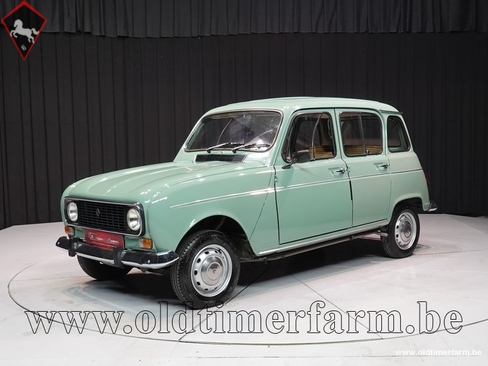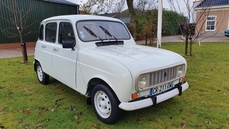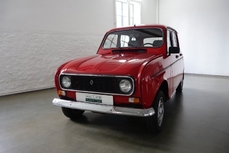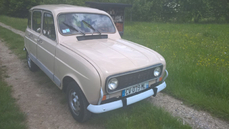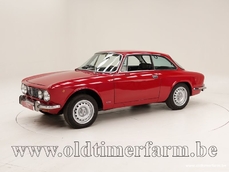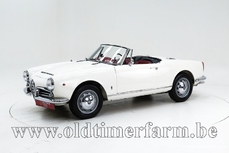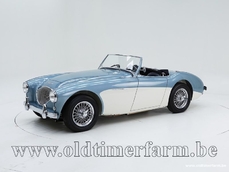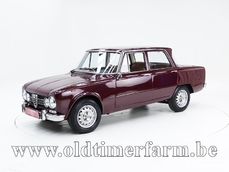Renault 4 '79 1979
Allgemeine Beschreibung :
The Renault 4 or R4 was produced between 1961 and 1994. It is renault's first front-wheel drive passenger car. In France one speaks of the 4L (pronounced "Quatrelle" or "Quatre ailes", which means "four wings"). In 1948 Renault's big competitor Citroën came on the market with the 2 CV. Renault had to respond to this, but in the meantime could also study the strengths and weaknesses of the 2CV. In the spring of 1956, Renault managing director Pierre Dreyfus started a project for a car that would be larger than the 2CV and that would also be more suitable for use in the city. The new car had to succeed the rear-wheel-damaged Renault 4 CV. It had to be suitable for everyone: a family car, a car for women, for farmers, for the city. Only in 1961 the Renault 4 was presented at the Salon de l'Automobile in Paris, in the Luxe (L) version, hence the name 4L, which is common in France. The first versions featured the 750cc engine of the Renault 4CV and a newly developed three-speed gearbox, the first gear of which was not synchronized. With this gearbox, the Renault 4 was behind the now thirteen-year-old Citroën 2CV, which had four instead of three gears. The body was screwed onto a chassis, while its predecessor, the 4CV, already had a self-supporting body. The chassis ran the risk of bending if the (firmness-giving) bodywork was removed; nevertheless, this construction gave Renault an advantage. On the same R4 chassis, Renault was later able to assemble the Renault 6. The R4 had independent suspension on all four wheels, all equipped with suspension by means of torsion bars. The wheelbase is 4 cm shorter on the left than on the right, making it very easy to perform the rear torsion suspension, without affecting the steering of the car. The handling of a Renault 4 is experienced as very comfortable, more comfortable than some modern cars. This is partly due to the smooth torsion bar suspension. During the production of the R4, the model was considered by many to be a station wagon, but in retrospect it might be better to call it one of the first hatchbacks. To date, the R4 did not get the cult status that the Citroën 2CV does, probably because it was the most successful French car of all time. The car was so common that preserving or cultivating the car simply wasn't done. Only in recent years has the cult status of the R4 increased. In the Netherlands, the R4 was for sale until 1986, but production continued in Slovenia, among others, at Revoz until 1993. A total of more than eight million Renaults 4 were produced. Despite its long production time, little was changed in the appearance of the Renault 4. In 1967, the chrome-plated "harp" grille was replaced by an aluminium grille with a Renault logo placed off-centre. There were hardly any changes in the sheet metal: the hood was slightly modified on versions with the 1108 cc engine, and the upper hinges of the door were moved from the outside to the inside in 1982, while the hinges of the tailgate were also reduced. The initially somewhat sm. all bumpers had their final shape from 1967. The interior was nice with comfortable seating, powerful heating and efficient ventilation. The sliding windows gave the R4 an extra character for some drivers, for others it was a sign of an outdated design. The gear lever distinguishes the Renault 4 from other cars, because it is not on the ground, but in the dashboard. The design was copied from the Citroën 2CV, and the result was a flat floor, with more space. The gear lever passed through the dashboard, on the engine and radiator to the gearbox, in front of the engine compartment. As is often the case with a different design, the gear lever was also criticized by journalists, although it was easy to handle. Despite the great success of the Renault 4 (or perhaps as a result of that), Renault has invested heavily in the development of small cars. The Renault 6 and Renault 5 were designed while the Renault 4 was still selling very well, and the R5 was a completely different type of car. This made the Renault 4 a bridge between small cars (2CV, Mini) and the three-door sports car (said Renault 5 and later also the Peugeot 205).
http://www.oldtimerfarm.be/en/collection-cars-for-sale/6657/renault-r4tl-79.php
1979 Renault 4 '79 is listed verkauft on ClassicDigest in Aalter by Oldtimerfarm Dealer for €10950.
Fakten der Auto
Karosserietyp : Auto Marke : Renault Modell : 4 Ausführung : '79 Hubraum : 0.0 Modelljahr : 1979 Lage : Aalter
Verkauft
Angaben Zum Verkäufer
Verkauft
People who viewed this Renault 4 also viewed similar Renault listed at ClassicDigest
Other cars listed for sale by this dealer
über Renault
Renault, ein Name, der so französisch ist wie ein Croissant und so tief in der Automobilgeschichte verwurzelt ist wie ein Baguette in einem Pariser Café. Lassen Sie uns eine gemütliche Fahrt durch die Annalen dieses traditionsreichen Herstellers unternehmen, sollen wir?Unsere Geschichte beginnt Ende des 19. Jahrhunderts, als die Brüder Renault, Louis, Marcel und Fernand, beschlossen, ihre erfinderischen Köpfe einzusetzen. Im Jahr 1898 stellten sie ihr allererstes Auto vor, den Renault Voiturette. Es war eine zierliche, heckgetriebene Apparatur, die wie etwas aussah, das Jules Verne entworfen haben könnte. Dieser winzige Vorreiter legte den Grundstein für Renaults Automobil-Erbe.
Nun, wenn wir über einflussreiche Renault-Modelle sprechen, dürfen wir den Renault 4 nicht übersehen. Eingeführt im Jahr 1961, war er die französische Antwort auf den Volkswagen Käfer. Der Renault 4 war praktisch, vielseitig und wurde entwickelt, um den Anforderungen des ländlichen Frankreichs gerecht zu werden. Er fühlte sich genauso wohl in der Stadt wie auf einem Bauernhof, eine wahre Verkörperung des französischen Pragmatismus.
Aber lassen Sie uns nicht den Renault 5 vergessen, oder "Le Supercinq", wie er in Frankreich genannt wurde. In den Mitte-70er Jahren eingeführt, war dieser kleine Kleinwagen eine Design-Sensation. Seine eigenwilligen, kantigen Linien und seine freche Persönlichkeit machten ihn sofort beliebt. Er war sparsam, Spaß zu fahren und wurde zu einem Symbol des französischen Stadtlebens.
Dann kam der Renault Espace im Jahr 1984. Er war einer der Vorreiter des MPV (Multi-Purpose Vehicle)-Segments. Der Espace war für Familien konzipiert, die die Praktikabilität eines Vans ohne den Komfort eines Autos wollten. Er markierte den Beginn einer neuen Ära im Bereich der Familienmobilität.
Und vergessen wir nicht den Renault Twingo, der 1992 eingeführt wurde. Er war ein kleiner Stadtwagen, der das traditionelle Konzept aufbrach, mit seinem innovativen Design und dem Heckmotor. Der Twingo war der Beweis, dass kleine Autos stilvoll und praktisch sein können, und er war ein Hit bei Stadtbewohnern in ganz Europa.
Nun, wenn wir über ein wahres Game-Changer sprechen wollen, dann ist es der Renault Clio. Erstmals im Jahr 1990 eingeführt, wurde der Clio zum europäischen Liebling. Er vereinte Stil, Leistung und Erschwinglichkeit auf eine Weise, die nur wenige Autos erreichen konnten. Er ist die Art von Auto, die sich sowohl auf den Champs-Élysées als auch in den engen Gassen eines französischen Dorfes wohl fühlt.
Aber natürlich dürfen wir den Renault Megane nicht vergessen. Seit seinem Debüt im Jahr 1995 ist er ein fester Bestandteil des Kompaktwagen-Segments. Mit seinem unverwechselbaren Heckdesign und einer Auswahl an Motoren für jeden Geschmack ist der Megane in einem hart umkämpften Markt weiterhin eine starke Konkurrenz.
Da haben Sie es, eine gemütliche Tour durch die Geschichte von Renault, einem Unternehmen, das immer einen Hauch von französischem Flair in die Welt des Automobils gebracht hat. Renault hat uns Autos geschenkt, die so vielfältig sind wie die französische Landschaft selbst, von praktischen Arbeitstieren bis hin zu stilvollen Stadtbewohnern. Es ist eine Marke, die genauso Teil des kulturellen Erbes Frankreichs ist wie eine Flasche Bordeaux oder eine Partie Boule. Vive la Renault
